The Influence of Storage Tank Volume on the Nighttime Heat Dissipation and Freezing Process of All-Glass Vacuum Tube Solar Water Heaters
Abstract
:1. Introduction
2. Methods
2.1. Thermal Analysis of All-Glass Vacuum Tube Solar Collectors for Heat Dissipation
2.2. Numerical Model for Evacuated Tube Solar Collectors
2.2.1. Simplified Physical Model
2.2.2. Governing Equation
2.2.3. Boundary Condition Settings
2.2.4. Mesh Independency Study
2.3. Heat Dissipation Experiment of All-Glass Vacuum Tube Solar Collector System
2.4. Experimental Data Collection and Numerical Model Validation
2.4.1. Experimental Data Collection
2.4.2. Numerical Model Validation
3. Analysis of Nighttime Heat Dissipation Process of All-Glass Vacuum Tube Collector
4. The Influence of Varying Volumes on the Numerical Model’s Heat Dissipation for Solar Collectors
4.1. Heat Dissipation and Freezing Process of Unit Volume of 7.5 L Heat Storage Water Tank
4.2. Heat Dissipation and Freezing Process of Unit Volume of 1 2.5 L Heat Storage Water Tank
4.3. Heat Dissipation and Freezing Process of Unit Volume of 1 5.0 L Heat Storage Water Tank
5. Conclusions
- (1)
- Experimental and simulation results demonstrate that during the heat dissipation process, the temperature decrease rate of the water inside the vacuum tube is significantly higher than that of the water inside the thermal storage tank at different time intervals. Freezing primarily occurs at the bottom surface of the vacuum tube. The temperature at the end of the vacuum tube is consistently the lowest within the tube, while the temperature at the junction between the vacuum tube and the thermal storage tank is the highest and exhibits the greatest temperature gradient and temperature difference. Solar water heaters in the Luoyang region are susceptible to freezing risks;
- (2)
- During the heat dissipation process, the all-glass vacuum tube solar collector experiences freezing. The frost thickness at the end of the vacuum tube is approximately 5 mm, with the remaining section of the cross-section consisting of a mixture of ice and water. The length of freezing extends to about 1180 mm. In the absence of a water tank, the freezing situation is severe, with approximately 4/5 of the single tube completely frozen;
- (3)
- The thermal storage tank has a significant impact on the heat dissipation and freezing process of the all-glass vacuum tube solar collector. Compared to a 10 L unit storage tank, reducing the volume to 7.5 L results in an increase of 4.5% in temperature drop for the storage tank and 3.8% for the vacuum tube. Conversely, increasing the volume to 15 L leads to a decrease of 12.1% in temperature drop for the storage tank and 7.6% for the vacuum tube. These results indicate that the volume of the water tank has a significant effect on the freezing process of the solar collector. A larger water tank volume results in slower freezing and longer working time for the solar collector.
Author Contributions
Funding
Data Availability Statement
Conflicts of Interest
Nomenclature
| h | Heat transfer coefficient, W/(m2·K) |
| R | Thermal resistance per unit length of the collector tube, (m·K)/W |
| T | Temperature, °C |
| m | Mass, kg |
| c | Specific heat, KJ/(kg·K) |
| U | Heat loss coefficient, W/K |
| Q | Heat flux, W/m2 |
| q | Net heat flux density, W/m2 |
| H | Enthalpy, J/kg |
| x | Horizontal coordinate, m |
| y | Axial coordinate, m |
| z | Vertical coordinate, m |
| A | Cross-sectional area, m2 |
| L | Cover glass tube diameter, m |
| Ri | Frozen water fraction |
| V | Volume, m3 |
| D | Axial length of vacuum, m |
| Ra | Reynolds number |
| v | Kinematic viscosity, m2/s |
| Cp | Specific heat capacity, KJ/(kg·K) |
| u | Horizontal coordinate velocity component |
| v | Axial coordinate velocity component |
| w | Vertical coordinate velocity component |
| t | Time |
| s2 | Variance |
| S | Variance mean |
| Greek letters | |
| ε | Emissivity |
| ρ | Density, kg/m3 |
| λ | Thermal conductivity, W/(K·m) |
| γ | Latent heat of water, J/kg |
| δ | Thickness, m |
| α | Thermal diffusivity, m2/s |
| β | Volume expansion coefficient, 1/K |
| Subscript | |
| a | Ambient |
| i | Inner glass tube |
| o | Outer glass tube, cover glass tube |
| g | Ground for radiation calculation |
| sky | Sky for radiation calculation |
| r | Radiative |
| c | Convective |
| eff | Efficient |
| wa | Water |
| lost | Heat lost |
| t | Tank |
| va | Vacuum |
| ic | Ice |
| G | Solar water heaters |
| P | Vacuum tube |
References
- Thirugnanasambandam, M.; Iniyan, S.; Goic, R. A review of solar thermal technologies. Renew. Sustain. Energy Rev. 2010, 14, 312–322. [Google Scholar] [CrossRef]
- Syahputra, R.; Soesanti, I. Renewable energy systems based on micro-hydro and solar photovoltaic for rural areas: A case study in Yogyakarta, Indonesia. Energy Rep. 2021, 7, 472–490. [Google Scholar] [CrossRef]
- Wang, T.-Y.; Zhao, Y.-H.; Diao, Y.-H.; Ren, R.-Y.; Wang, Z.-Y. Performance of a new type of solar air collector with transparent-vacuum glass tube based on micro-heat pipe arrays. Energy 2019, 177, 16–28. [Google Scholar] [CrossRef]
- Zhu, T.-T.; Zhao, Y.-H.; Diao, Y.-H.; Li, F.-F.; Quan, Z.-H. Experimental investigation and performance evaluation of a vacuum tube solar air collector based on micro heat pipe arrays. J. Clean. Prod. 2017, 142, 3517–3526. [Google Scholar] [CrossRef]
- Barone, G.; Buonomano, A.; Chang, R.; Forzano, C.; Giuzio, G.F.; Mondol, J.; Palombo, A.; Pugsley, A.; Smyth, M.; Zacharopoulos, A. Modelling and simulation of building integrated Concentrating Photovoltaic/Thermal Glazing (CoPVTG) systems: Comprehensive energy and economic analysis. Renew. Energy 2022, 193, 1121–1131. [Google Scholar] [CrossRef]
- Abdelrazik, A.; Shboul, B.; Elwardany, M.; Zohny, R.; Osama, A. The recent advancements in the building integrated photovoltaic/thermal (BIPV/T) systems: An updated review. Renew. Sustain. Energy Rev. 2022, 170, 112988. [Google Scholar] [CrossRef]
- Qiao, X.; Kong, X.; Fan, M. Phase change material applied in solar heating for buildings: A review. J. Energy Storage 2022, 55, 105826. [Google Scholar] [CrossRef]
- Li, T.; Liu, Q.; Liu, L.; Li, Y.; Yu, J.; Wang, X.; Mao, Q. Feasibility study on solar coupled gas-fired boiler heating system retrofit in residential buildings in the HSCW zone of China. Case Stud. Therm. Eng. 2023, 42, 102698. [Google Scholar] [CrossRef]
- Louvet, Y.; Pag, F.; Ritter, D.; Schmelzer, C.; Vajen, K. About common but avoidable faults during planning, installation, and operation of solar heating plants in industrial applications. Sol. Energy Adv. 2022, 2, 100029. [Google Scholar] [CrossRef]
- Philip, N.; Duraipandi, S.; Sreekumar, A. Techno-economic analysis of greenhouse solar dryer for drying agricultural produce. Renew. Energy 2022, 199, 613–627. [Google Scholar] [CrossRef]
- Kumar, M.; Haillot, D.; Gibout, S. Survey and evaluation of solar technologies for agricultural greenhouse application. Solar Energy 2022, 232, 18–34. [Google Scholar] [CrossRef]
- Katsaprakakis, D. Introducing a solar-combi system for hot water production and swimming pools heating in the Pancretan Stadium, Crete, Greece. Energy Procedia 2019, 159, 174–179. [Google Scholar] [CrossRef]
- Katsaprakakis, D.A. Computational Simulation and Dimensioning of Solar-Combi Systems for Large-Size Sports Facilities: A Case Study for the Pancretan Stadium, Crete, Greece. Energies 2020, 13, 2285. [Google Scholar] [CrossRef]
- Daghigh, R.; Shafieian, A. Theoretical and experimental analysis of thermal performance of a solar water heating system with evacuated tube heat pipe collector. Appl. Therm. Eng. 2016, 103, 1219–1227. [Google Scholar] [CrossRef]
- Shafieian, A.; Khiadani, M.; Nosrati, A. Thermal performance of an evacuated tube heat pipe solar water heating system in cold season. Appl. Therm. Eng. 2019, 149, 644–657. [Google Scholar] [CrossRef]
- Sabiha, M.A.; Saidur, R.; Mekhilef, S.; Mahian, O. Progress and latest developments of evacuated tube solar collectors. Renew. Sustain. Energy Rev. 2015, 51, 1038–1054. [Google Scholar] [CrossRef]
- Elsheniti, M.B.; Kotb, A.; Elsamni, O. Thermal performance of a heat-pipe evacuated-tube solar collector at high inlet temperatures. Appl. Therm. Eng. 2019, 154, 315–325. [Google Scholar] [CrossRef]
- Elmetwalli, A.; Darwesh, M.; Amer, M.; Ghoname, M. Influence of solar radiation and surrounding temperature on heating water inside solar collector tank. J. Energy Storage 2021, 47, 103648. [Google Scholar] [CrossRef]
- Deshmukh, K.; Karmare, S.; Patil, P. Experimental investigation of convective heat transfer performance of TiN nanofluid charged U-pipe evacuated tube solar thermal collector. Appl. Therm. Eng. 2023, 225, 120199. [Google Scholar] [CrossRef]
- Wu, Y.; Rong, J.; Wang, D.; Zhao, X.; Meng, L.; Arıcı, M.; Liu, C.; Yang, R.; Li, D. Synergistic enhancement of heat transfer and thermal storage characteristics of shell and tube heat exchanger with hybrid nanoparticles for solar energy utilization. J. Clean. Prod. 2023, 387, 135882. [Google Scholar] [CrossRef]
- Pierucci, G.; Hosouli, S.; Salvestroni, M.; Messeri, M.; Fagioli, F.; De Lucia, M. Indoor thermal loss test on small-size solar receiver (UF-RT01) for process heat application. Sol. Energy Adv. 2021, 1, 100010. [Google Scholar] [CrossRef]
- Chandra, Y.P.; Singh, A.; Mohapatra, S.K.; Kesari, J.; Rana, L. Numerical optimization and convective thermal loss analysis of improved solar parabolic trough collector receiver system with one sided thermal insulation. Sol. Energy 2017, 148, 36–48. [Google Scholar] [CrossRef]
- Arés-Muzio, O.; Lizama-Tzec, I.; Macias, J.; Oskam, G.; Cahue, A.; de Coss, R.; Alvarado-Gil, J.; Cortes, C. Characterization of Thermal Losses in an Evacuated Tubular Solar Collector Prototype for Medium Temperature Applications. Energy Procedia 2014, 57, 2121–2130. [Google Scholar] [CrossRef] [Green Version]
- Singh, N.; Khullar, V. Experimental and theoretical investigation into effectiveness of ZnO based transparent heat mirror covers in mitigating thermal losses in volumetric absorption based solar thermal systems. Sol. Energy 2023, 253, 439–452. [Google Scholar] [CrossRef]
- Zhu, Y.; Li, P.; Ruan, Z.; Yuan, Y. A model and thermal loss evaluation of a direct-absorption solar collector under the influence of radiation. Energy Convers. Manag. 2021, 251, 114933. [Google Scholar] [CrossRef]
- Nokhosteen, A.; Sobhansarbandi, S. Novel method of thermal behavior prediction of evacuated tube solar collector. Sol. Energy 2020, 204, 761–768. [Google Scholar] [CrossRef]
- Yuan, Y.; Wu, G.; Yang, Q.; Cheng, R. Experimental and analytical optical-thermal performance of evacuated cylindrical tube receiver for solar dish collector. Energy 2021, 234, 121301. [Google Scholar] [CrossRef]
- Kafle, B.P.; Basnet, B.; Timalsina, B.; Deo, A.; Malla, T.N.; Acharya, N.; Adhikari, A. Optical, structural and thermal performances of black nickel selective coatings for solar thermal collectors. Sol. Energy 2022, 234, 262–274. [Google Scholar] [CrossRef]
- Yang, Z.; Chen, H.; Wang, L.; Sheng, Y.; Wang, Y. Comparative study of the influences of different water tank shapes on thermal energy storage capacity and thermal stratification. Renew. Energy 2016, 85, 31–44. [Google Scholar] [CrossRef]
- Li, Q.; Huang, X.; Tai, Y.; Gao, W.; Wenxian, L.; Liu, W. Thermal stratification in a solar hot water storage tank with mantle heat exchanger. Renew. Energy 2021, 173, 1–11. [Google Scholar] [CrossRef]
- Li, Q.; Lin, W.; Huang, X.; Tai, Y.; Ding, X.; Zhang, Y.; Gao, W. Thermocline dynamics in a thermally stratified water tank under different operation modes. Appl. Therm. Eng. 2022, 212, 118560. [Google Scholar] [CrossRef]
- Lyu, W.; Wang, Z.; Li, X.; Deng, G.; Xu, Z.; Li, H.; Yang, Y.; Zhan, B.; Zhao, M. Influence of the water tank size and air source heat pump size on the energy saving potential of the energy storage heating system. J. Energy Storage 2022, 55, 105542. [Google Scholar] [CrossRef]
- Carmona, M.; Rincón, A.; Gulfo, L. Energy and exergy model with parametric study of a hot water storage tank with PCM for domestic applications and experimental validation for multiple operational scenarios. Energy Convers. Manag. 2020, 222, 113189. [Google Scholar] [CrossRef]
- Fan, J.; Furbo, S. Thermal stratification in a hot water tank established by heat loss from the tank. Sol. Energy 2012, 86, 3460–3469. [Google Scholar] [CrossRef]
- Katsaprakakis, D.A.; Zidianakis, G. Optimized Dimensioning and Operation Automation for a Solar-Combi System for Indoor Space Heating. A Case Study for a School Building in Crete. Energies 2019, 12, 177. [Google Scholar] [CrossRef] [Green Version]
- Nokhosteen, A.; Sobhansarbandi, S. Numerical modeling and experimental cross-validation of a solar thermal collector through an innovative hybrid CFD model. Renew. Energy 2021, 172, 918–928. [Google Scholar] [CrossRef]
- Liu, H.; Zhang, S.; Jiang, Y.; Yao, Y. Simulation analysis of a solar assisted heat pump system for space heating in severe cold areas. Build. Serv. Eng. Res. Technol. 2015, 36, 500–518. [Google Scholar] [CrossRef]
- Khedari, J.; Waewsak, J.; Thepa, S.; Hirunlabh, J. Field investigation of night radiation cooling under tropical climate. Renew. Energy 2000, 20, 183–193. [Google Scholar] [CrossRef]
- Li, Q.; Gao, W.; Lin, W.; Liu, T.; Zhang, Y.; Ding, X.; Huang, X.; Liu, W. Experiment and simulation study on convective heat transfer of all-glass evacuated tube solar collector. Renew. Energy 2020, 152, 1129–1139. [Google Scholar] [CrossRef]
- Chen, F.; Liu, Y. Model construction and performance investigation of multi-section compound parabolic concentrator with solar vacuum tube. Energy 2022, 250, 123887. [Google Scholar] [CrossRef]
- Du, B.; Lund, P.D.; Wang, J. Combining CFD and artificial neural network techniques to predict the thermal performance of all-glass straight evacuated tube solar collector. Energy 2020, 220, 119713. [Google Scholar] [CrossRef]
- Li, T.; Wang, Z.; Yu, J.; Mao, Q. Experimental and simulation on night heat dissipation characteristics and freezing process of evacuated tube solar water heaters. Int. J. Therm. Sci. 2023, 192, 108455. [Google Scholar] [CrossRef]
- Taylor, R.A.; Hewakuruppu, Y.; DeJarnette, D.; Otanicar, T.P. Comparison of selective transmitters for solar thermal applications. Appl. Opt. 2016, 55, 3829–3839. [Google Scholar] [CrossRef]
- Jafarkazemi, F.; Abdi, H. Evacuated tube solar heat pipe collector model and associated tests. J. Renew. Sustain. Energy 2012, 4, 023101. [Google Scholar] [CrossRef]


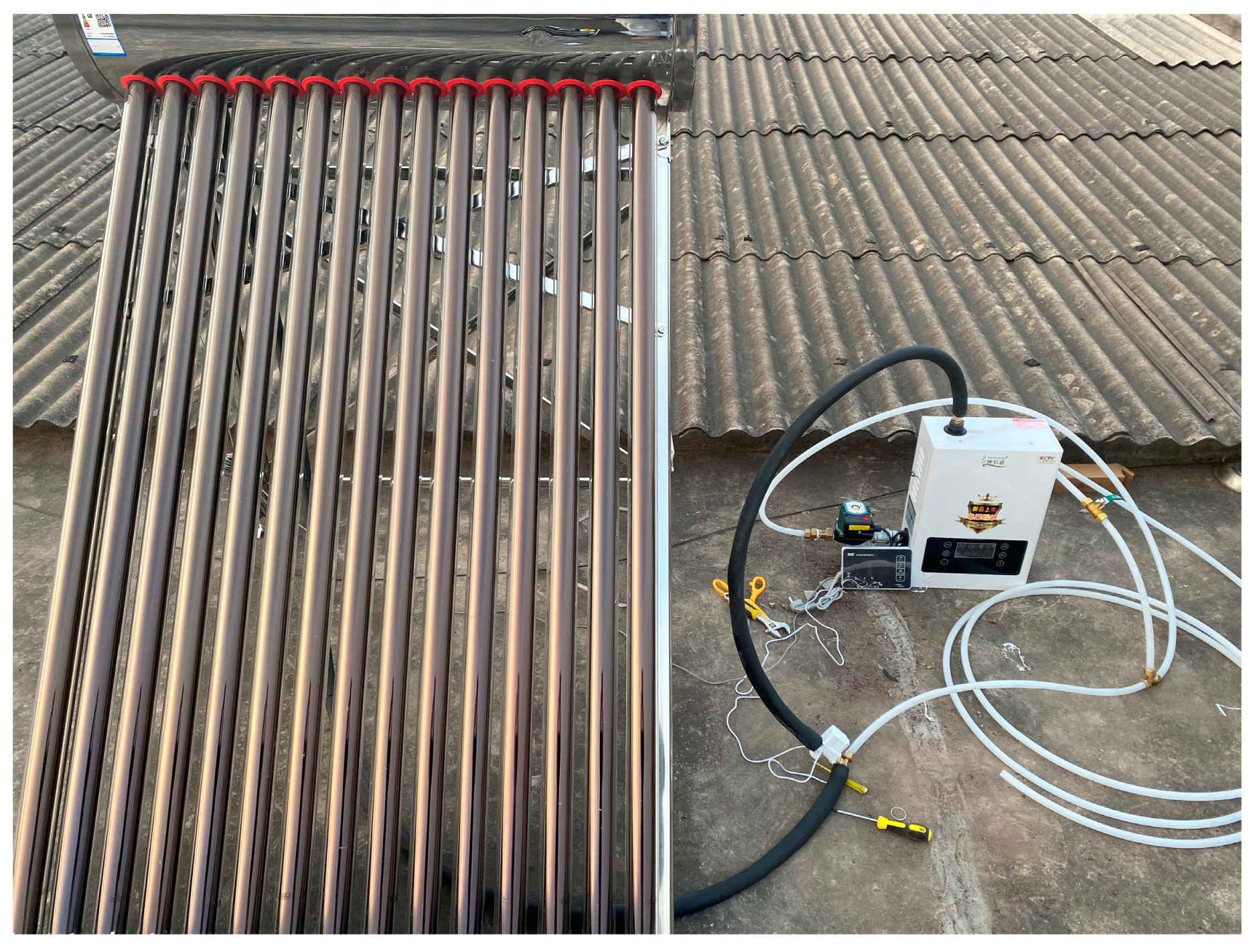
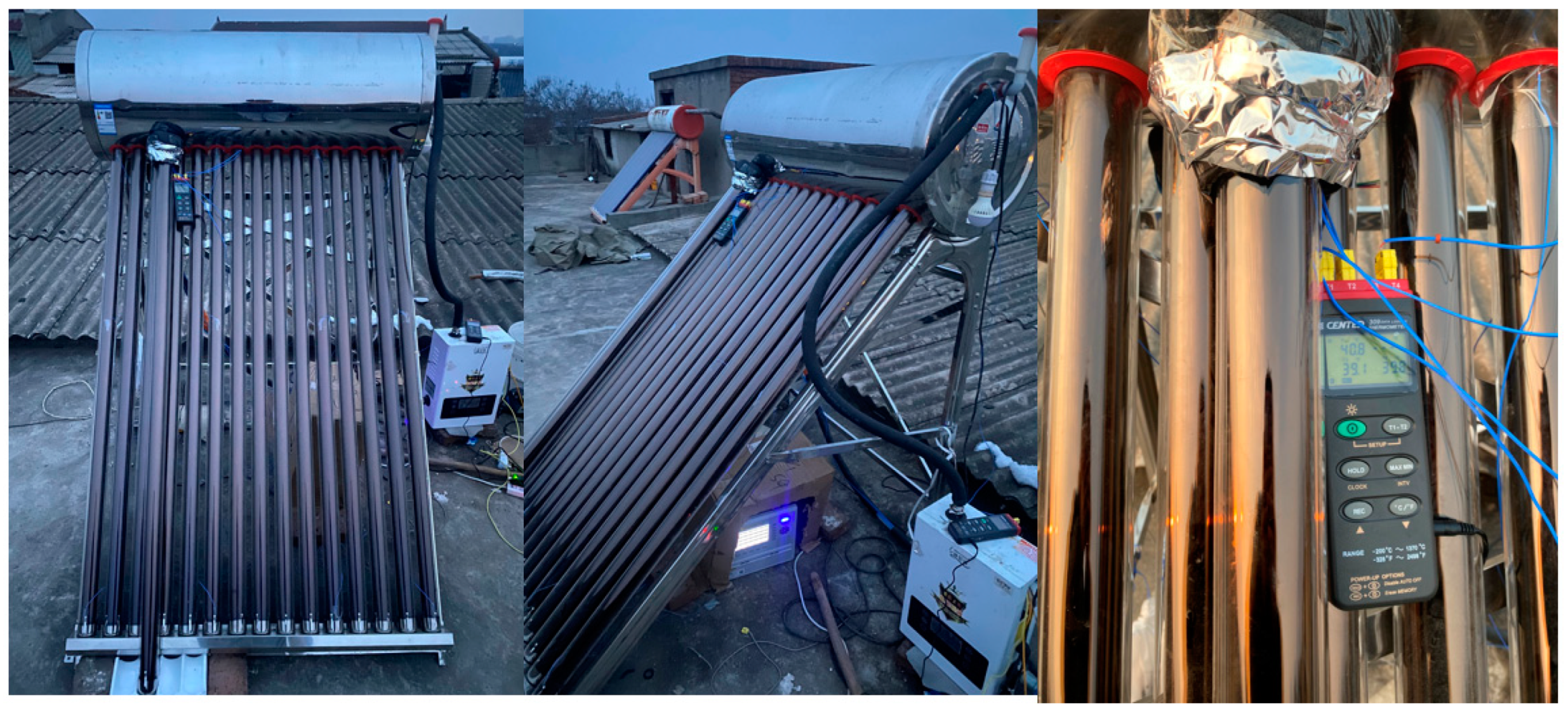

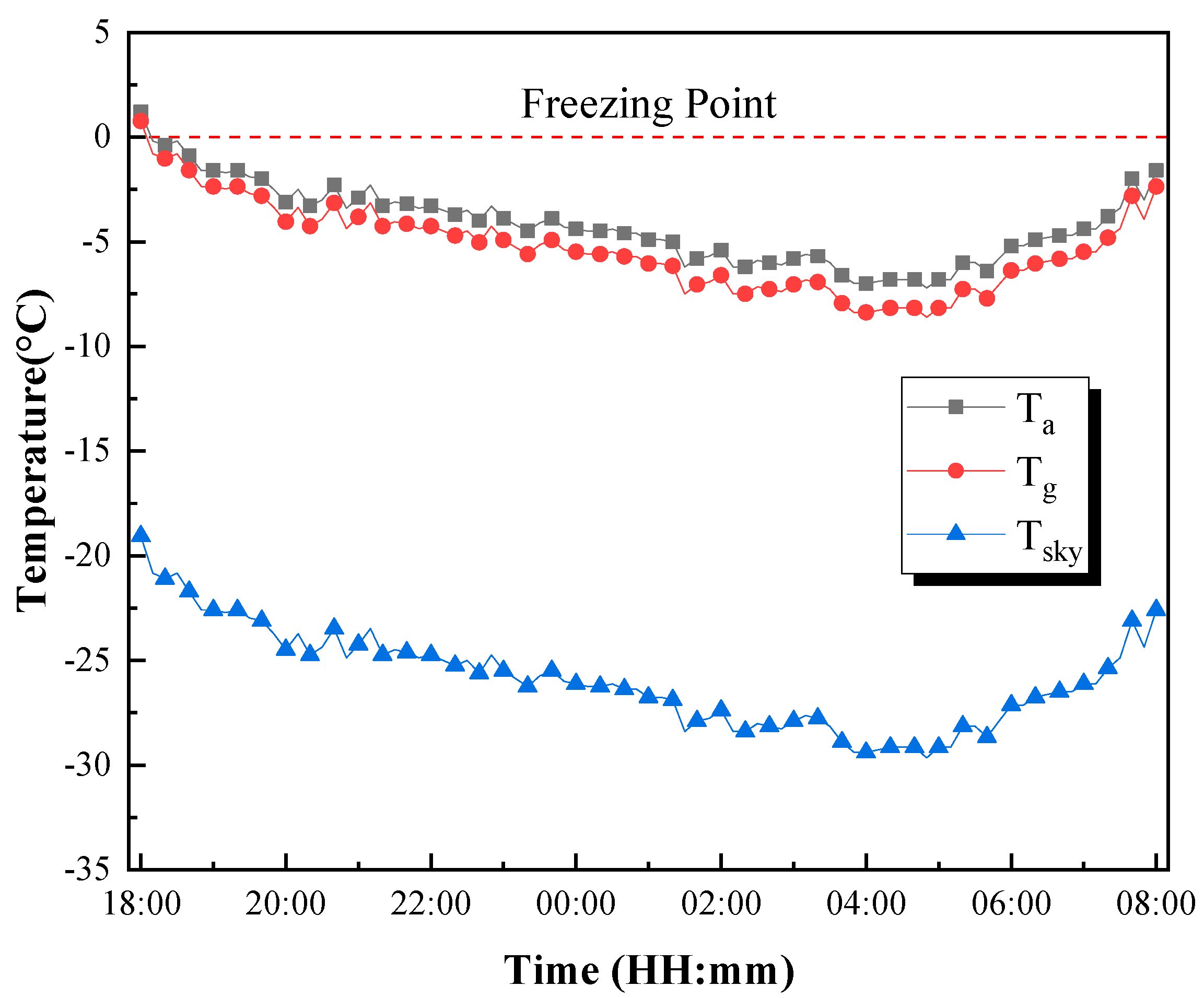

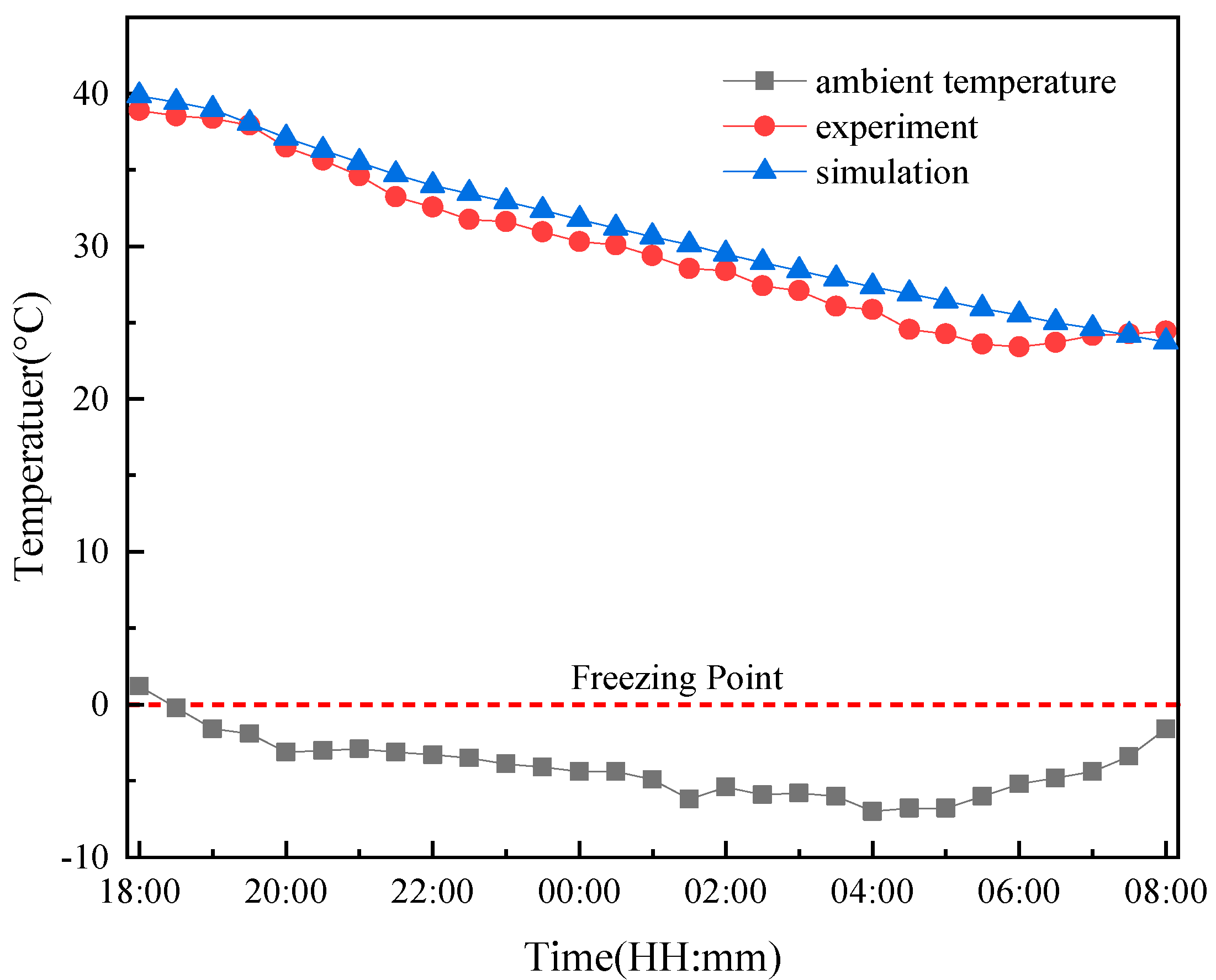
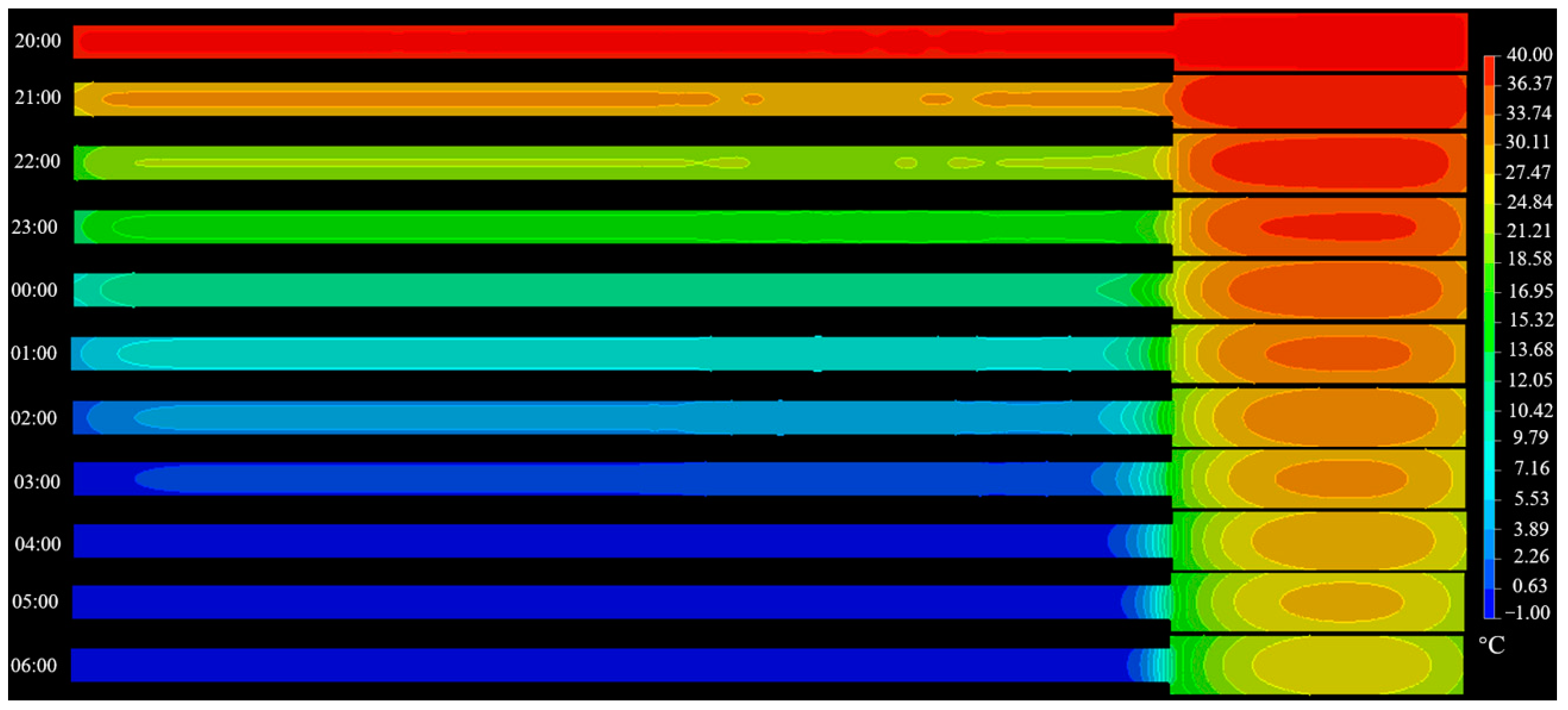

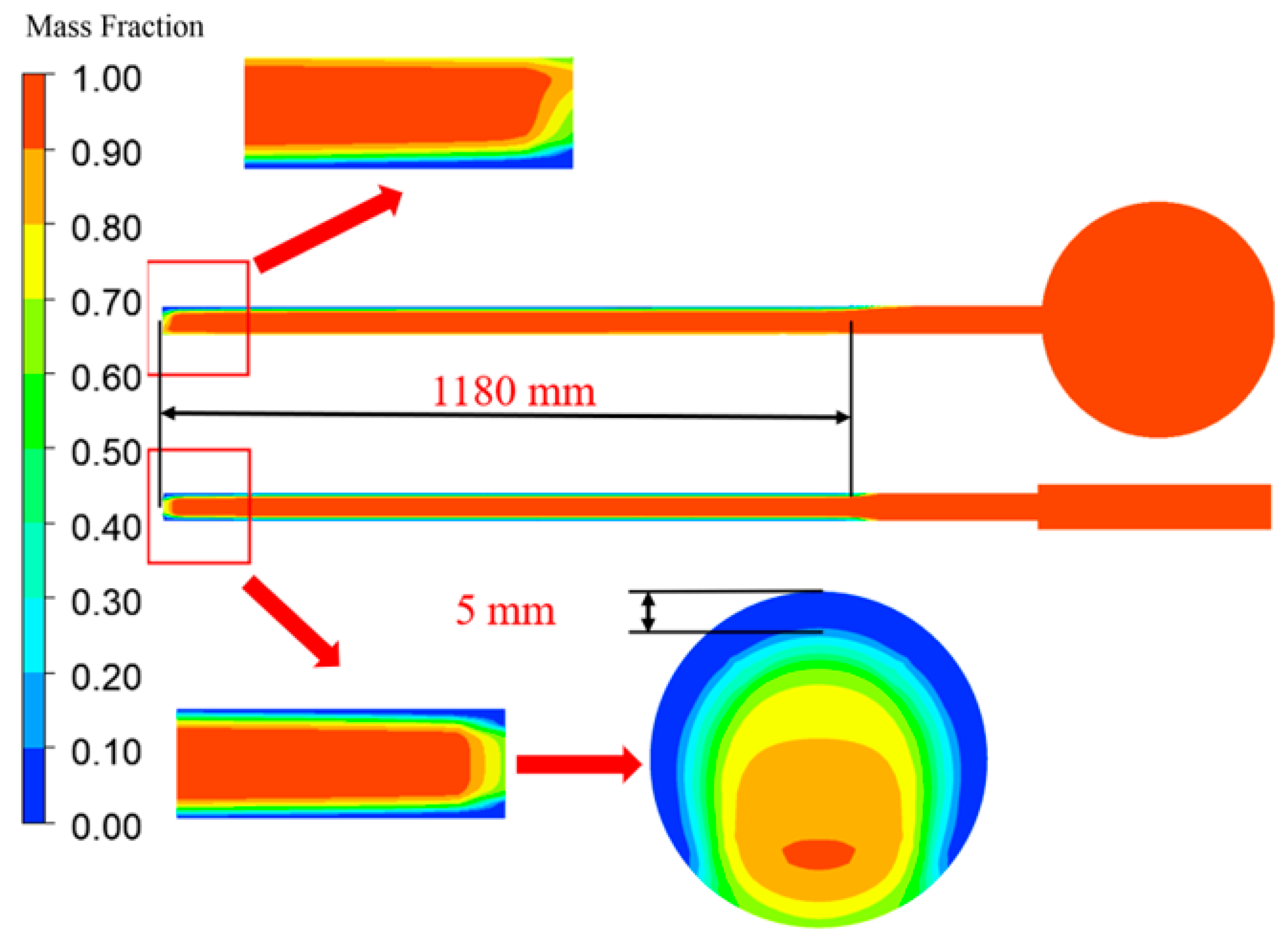


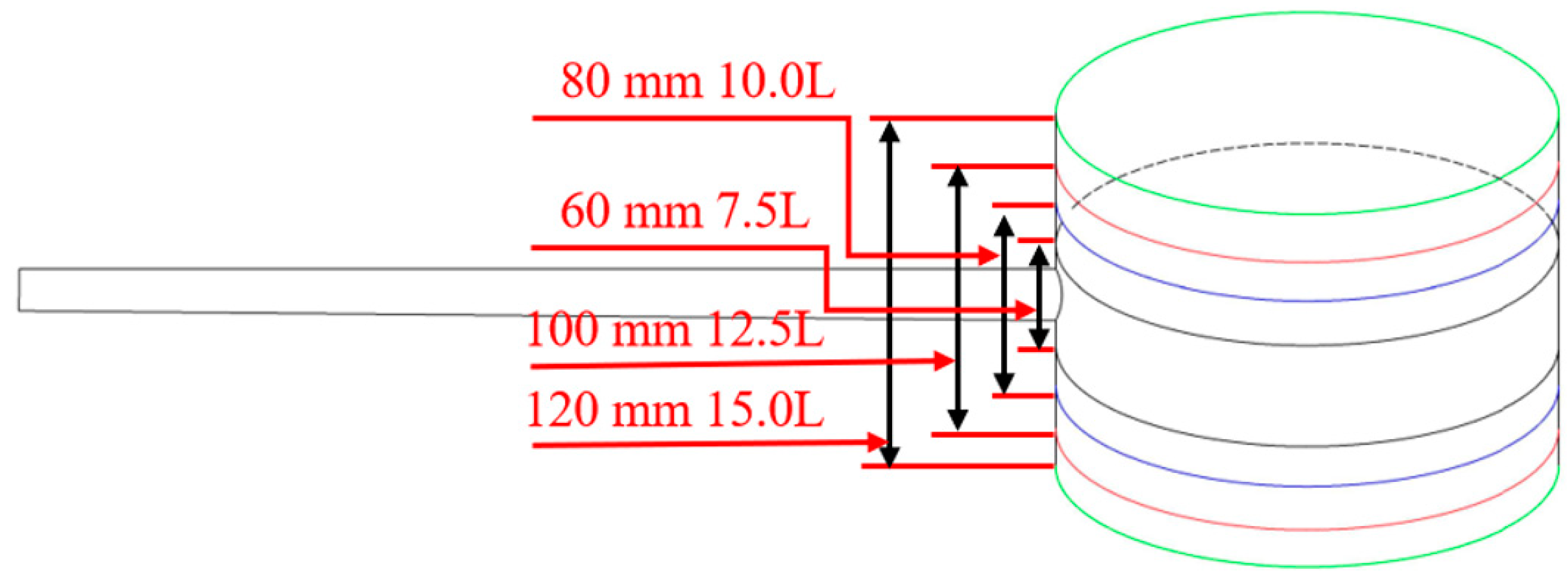
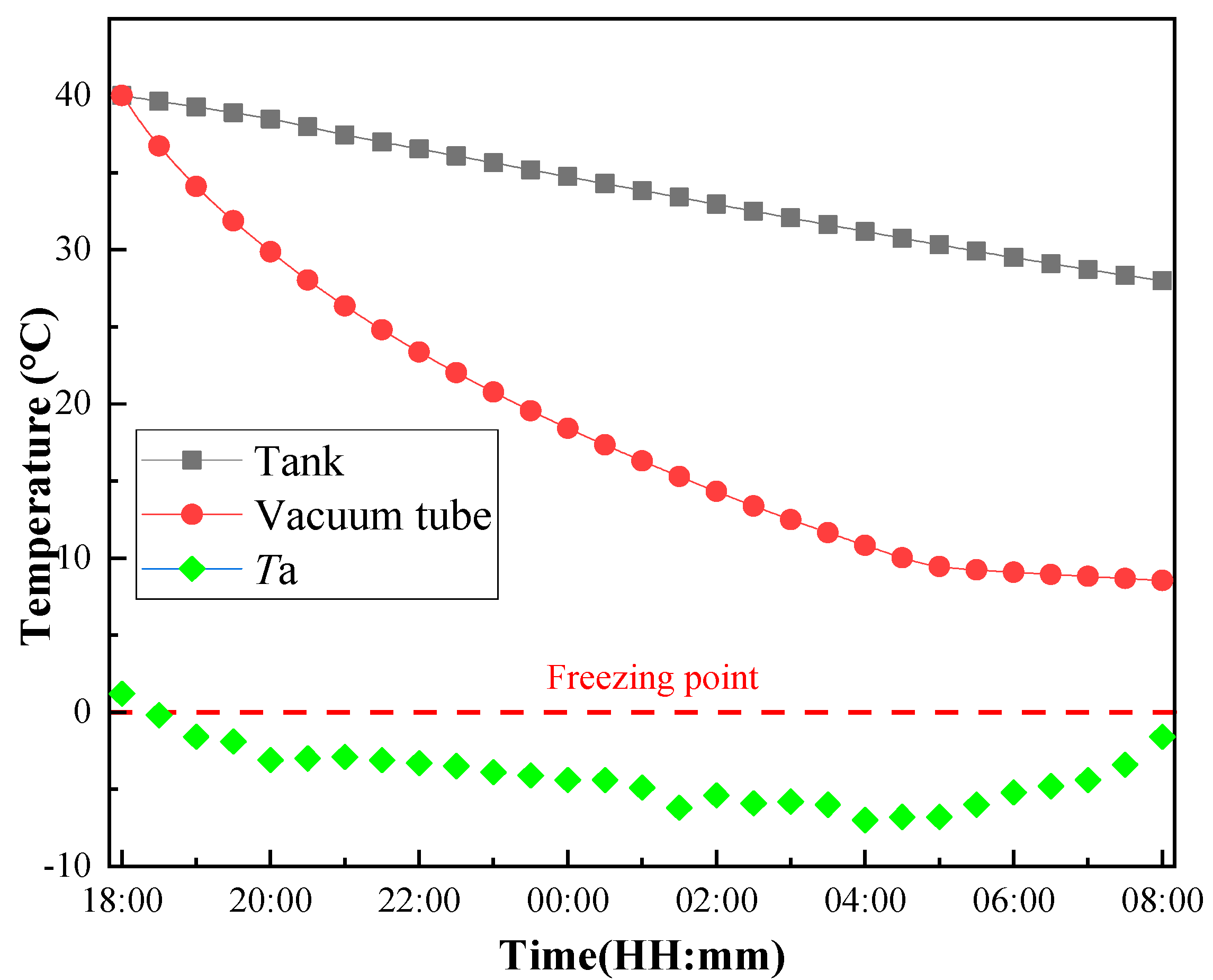
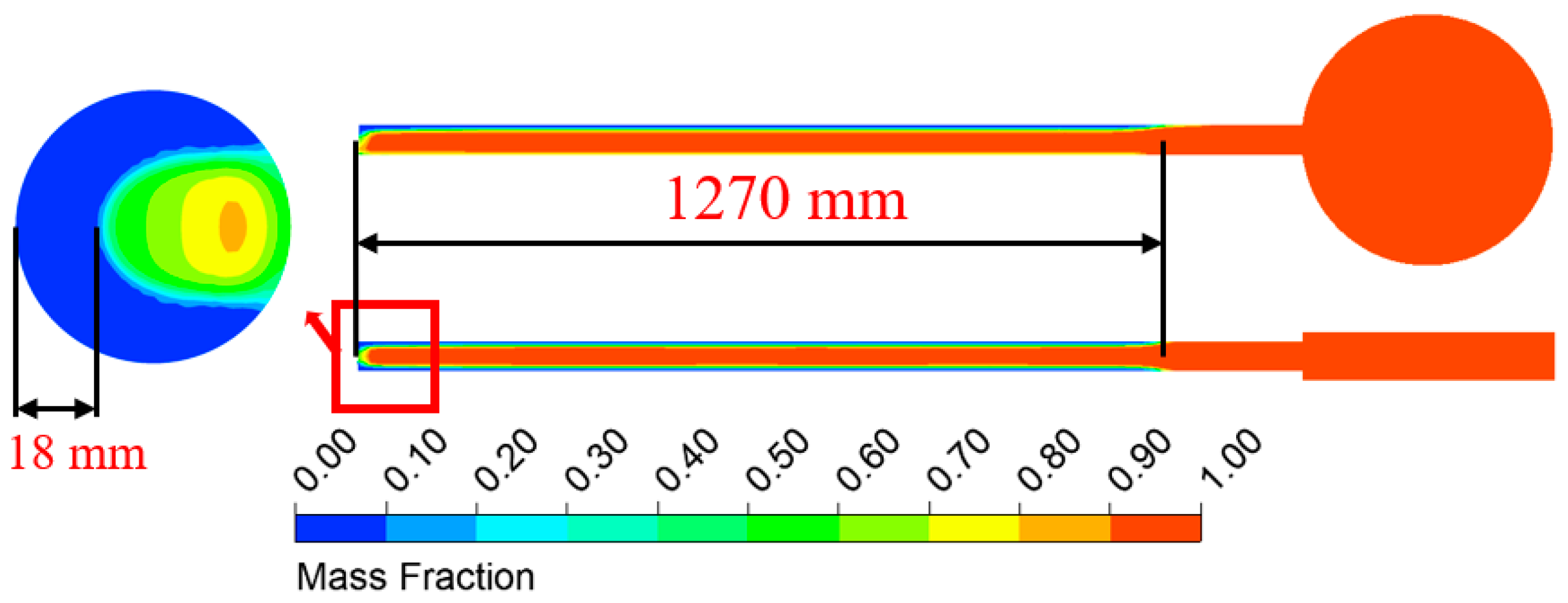
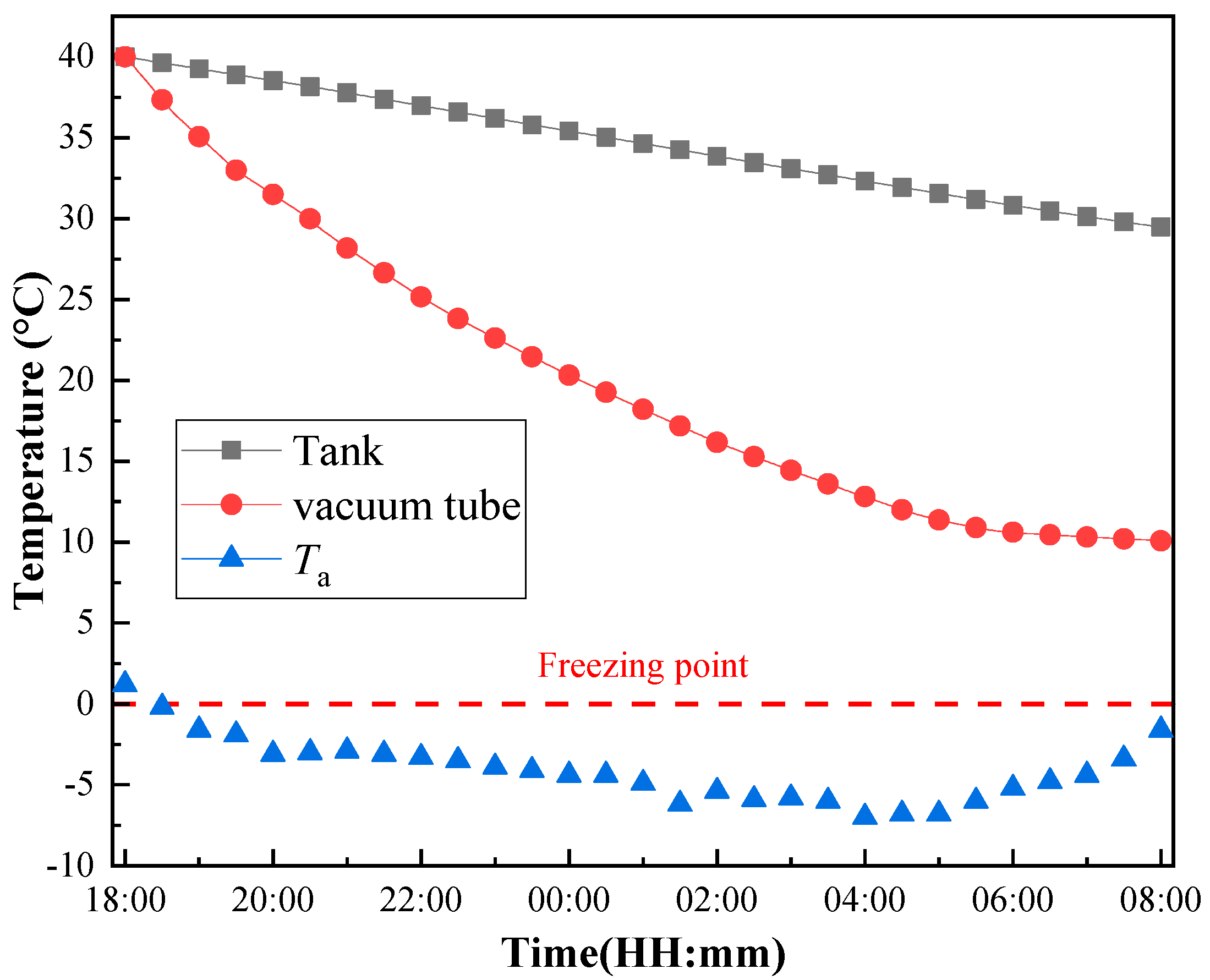

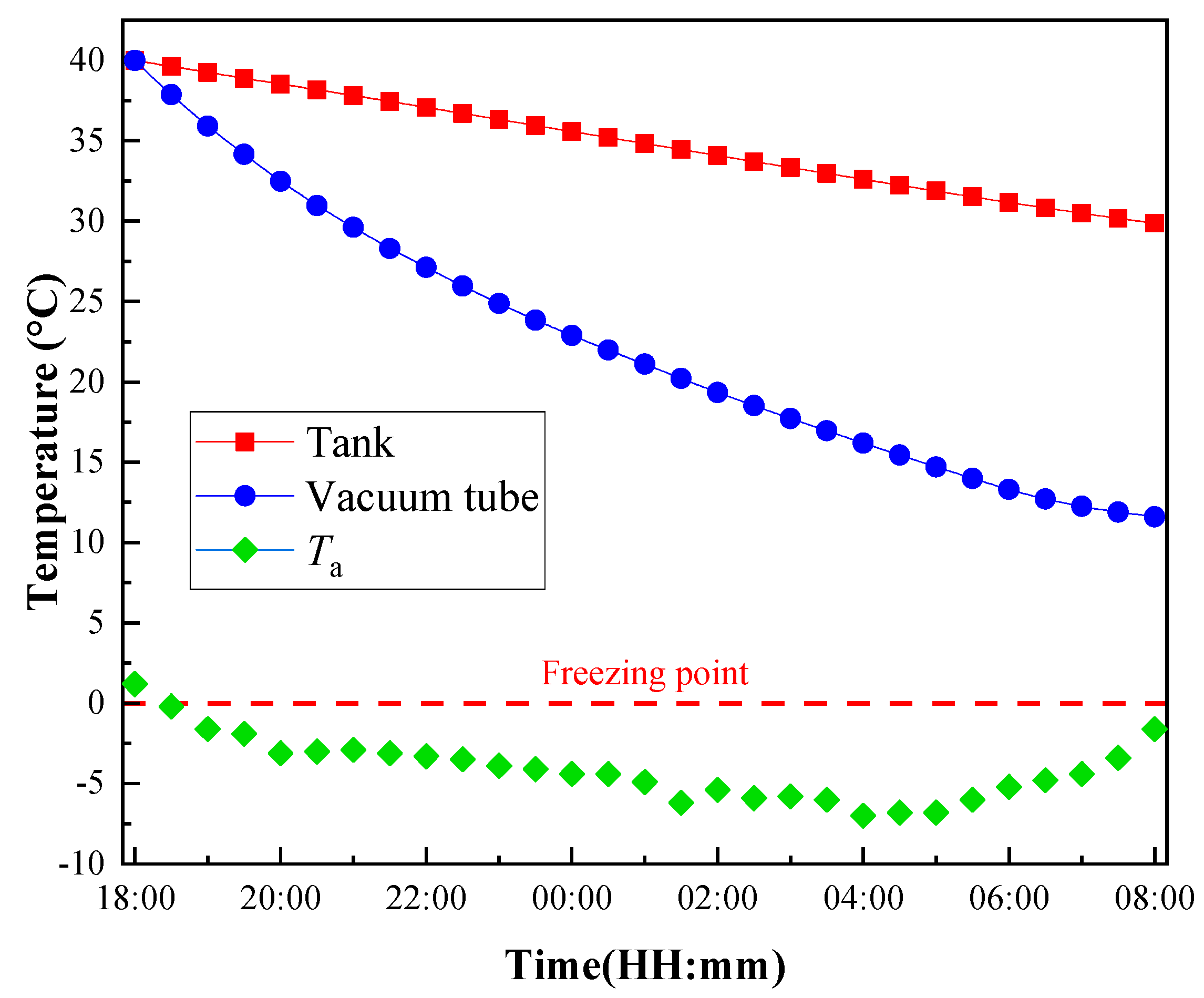

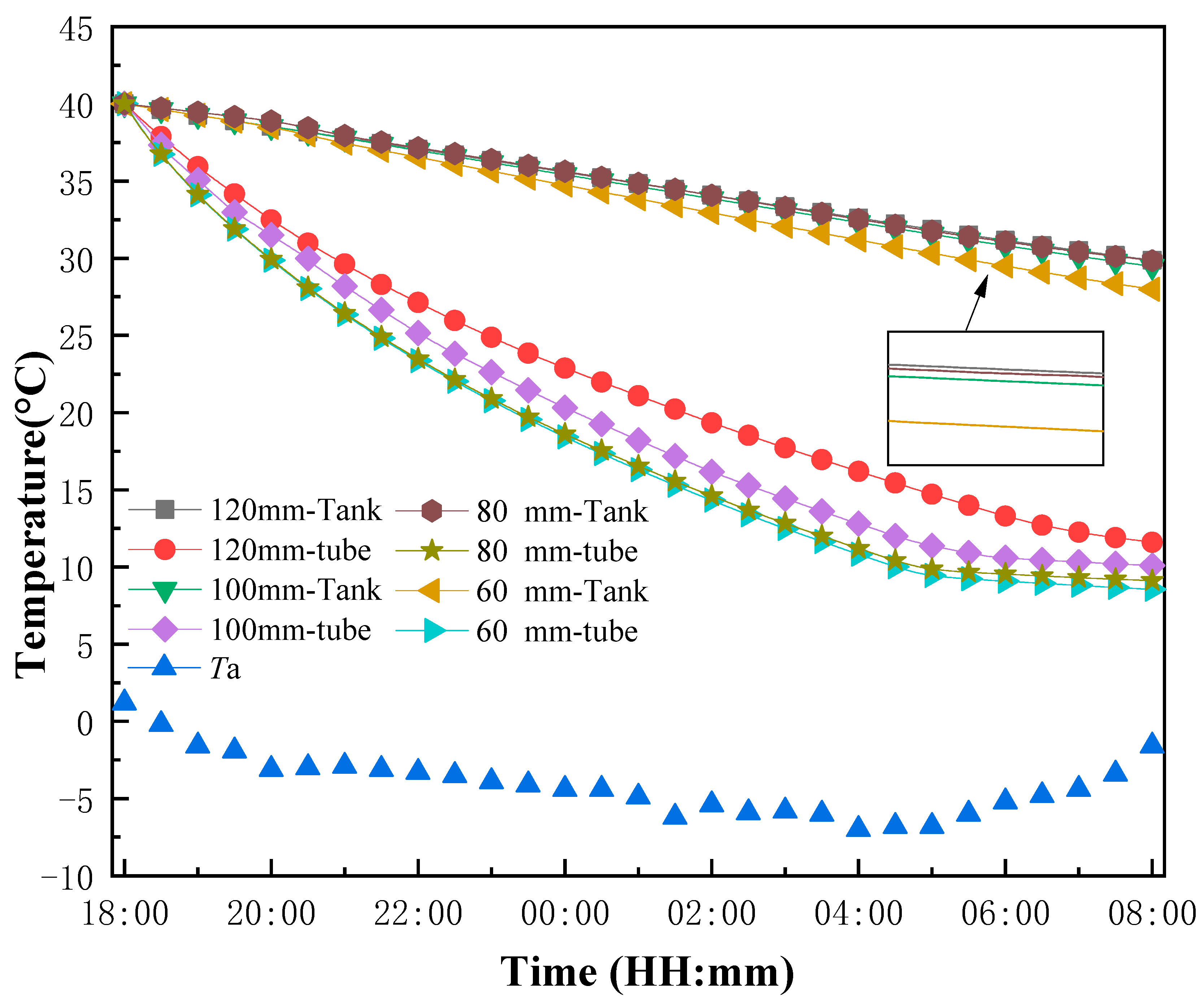
| Parameter | Unit | Value |
|---|---|---|
| Heat storage water tank | mm | 80.0 × 400.0 |
| The radius of the outer glass tube of the vacuum tube | mm | 58 |
| The radius of the inner glass tube of the vacuum tube | mm | 47 |
| Vacuum tube length | mm | 1500 |
| Size of simulation unit along the x-direction | mm | −200~200 |
| Size of simulation unit along the y-direction | mm | −200~1700 |
| Size of simulation unit along the z-direction | mm | −40~40 |
| Material | Option | Parameter |
|---|---|---|
| Water | Density (kg/m3) | 998.2 |
| Specific Heat (J/kg·K) | 418 | |
| Thermal Conductivity (W/m·K) | 0.6 | |
| Refractive Index | 1.5 | |
| Vacuum | Density (kg/m3) | 1.225 |
| Specific Heat (J/kg·K) | 1 × 10−5 | |
| Thermal Conductivity (W/m·K) | 0.00204 | |
| Viscosity (kg/m·s) | 1 × 10−5 | |
| Glass | Density (kg/m3) | 2220 |
| Specific Heat (J/kg·K) | 745 | |
| Thermal Conductivity (W/m·K) | 1.31 | |
| Refractive Index | 1.5 | |
| Insulation | Density (kg/m3) | 40 |
| Specific Heat (J/kg·K) | 871 | |
| Thermal Conductivity (W/m·K) | 0.024 | |
| Heat Absorber | Density (kg/m3) | 8300 |
| Thermal Conductivity (W/m·K) | 202.4 | |
| Refractive Index | 1.5 | |
| Absorption Coefficient | 0.6 |
| Monitor | Coordinate | Location |
|---|---|---|
| T0 | Y = 0 | Middle of tank |
| P1 | Y = 200 | Connection between tube and tank |
| P2 | Y = 800 | Middle of tube |
| P3 | Y = 1700 | Tube end |
| Grid Scheme | 1 | 2 | 3 | 4 |
|---|---|---|---|---|
| Grid cells | 281,344 | 364,624 | 416,240 | 504,968 |
| Grid nodes | 301,418 | 391,263 | 446,033 | 536,119 |
| T0 (°C) | 29.084 | 29.101 | 29.136 | 29.491 |
| P1 (°C) | 1.054 | 1.263 | 1.299 | 1.310 |
| P2 (°C) | −0.327 | −0.205 | −0.181 | −0.177 |
| P3 (°C) | −0.822 | −0.612 | −0.591 | −0.587 |
Disclaimer/Publisher’s Note: The statements, opinions and data contained in all publications are solely those of the individual author(s) and contributor(s) and not of MDPI and/or the editor(s). MDPI and/or the editor(s) disclaim responsibility for any injury to people or property resulting from any ideas, methods, instructions or products referred to in the content. |
© 2023 by the authors. Licensee MDPI, Basel, Switzerland. This article is an open access article distributed under the terms and conditions of the Creative Commons Attribution (CC BY) license (https://creativecommons.org/licenses/by/4.0/).
Share and Cite
Wang, S.; Wang, X.; Mao, M.; Wang, Y.; Liu, S.; Luo, B.; Li, T. The Influence of Storage Tank Volume on the Nighttime Heat Dissipation and Freezing Process of All-Glass Vacuum Tube Solar Water Heaters. Energies 2023, 16, 4781. https://doi.org/10.3390/en16124781
Wang S, Wang X, Mao M, Wang Y, Liu S, Luo B, Li T. The Influence of Storage Tank Volume on the Nighttime Heat Dissipation and Freezing Process of All-Glass Vacuum Tube Solar Water Heaters. Energies. 2023; 16(12):4781. https://doi.org/10.3390/en16124781
Chicago/Turabian StyleWang, Shidong, Xing Wang, Mingqiang Mao, Yongtao Wang, Shiping Liu, Baoming Luo, and Tao Li. 2023. "The Influence of Storage Tank Volume on the Nighttime Heat Dissipation and Freezing Process of All-Glass Vacuum Tube Solar Water Heaters" Energies 16, no. 12: 4781. https://doi.org/10.3390/en16124781
APA StyleWang, S., Wang, X., Mao, M., Wang, Y., Liu, S., Luo, B., & Li, T. (2023). The Influence of Storage Tank Volume on the Nighttime Heat Dissipation and Freezing Process of All-Glass Vacuum Tube Solar Water Heaters. Energies, 16(12), 4781. https://doi.org/10.3390/en16124781







